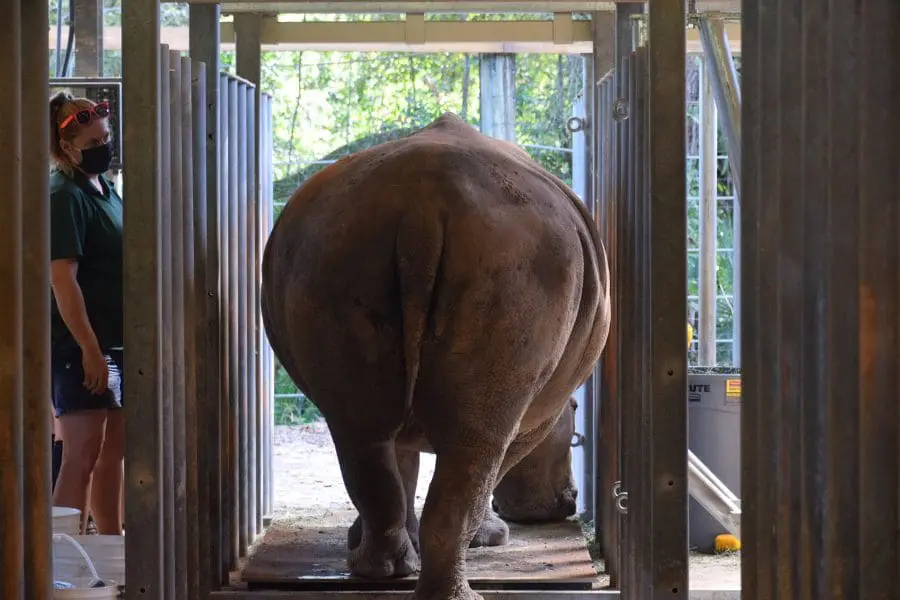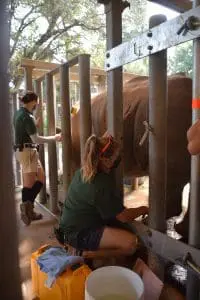

Expedition Africa Supervisor Chelsea trains one of our female rhinos to stand in a chute.
Editor’s note: This is the first in a series of blogs on the process of using artificial insemination to breed our rhinos. Please stay tuned for further updates!
March 18, 2022 Update: Rhino Uzuri recently received a dental procedure, after which we began tracking her ovaries with routine ultrasounds and collecting blood for hormone analysis. At this point, she has gotten two progesterone injections and we are tracking her follicular development. Once she reaches baseline for progesterone, we will move forward with scheduling the AI procedure.
Southern white rhinoceroses have called our Zoo home since 2003. Like our guests, we love watching these gentle giants munch on snacks, roll in the mud and roam their habitat. While it’s fun to watch them play, it’s also important to remember that their species is near threatened in their natural range due to habitat loss and human hunting.
As an Association of Zoos and Aquariums (AZA) accredited facility, we are committed to caring for not only the animals here at the Zoo, but also wildlife all over the world. It’s important to have a healthy population of southern white rhinos with long-term genetic diversity for the future of these animals.
We want to do our part in supporting this near-threatened species. After years of caring for southern white rhinos with no successful conception at our Zoo, we are turning to science to breed this critical species.
Frankie’s Big Debut
You may remember that in late 2018, we welcomed male southern white rhinoceros Frankie as part of the AZA Species Survival Plan (SSP) breeding program. Through this plan, Frankie’s genetics were determined to be a good match with our two females, 21-year-old female Uzuri and 20-year-old female Kibibi, and we crossed our fingers for baby rhinos!
Back in early 2019, our team began making changes to give our rhinos the best chance at conceiving naturally. “I worked with a nutritionist to design a program to help our females lose some extra weight they had on them and limit phytoestrogens (plant-based compounds that mimic estrogen in the body),” said Expedition Africa Supervisor Chelsea Herman. “Research showed that both of those variables can have negative impacts on the reproductive system.”
Several other changes were made including giving our rhinos more time to forage and exhibit natural behaviors. Our team also designed an initial training chute in the Expedition Africa barn to prepare Uzuri and Kibibi for the ultrasounds necessary to track their potential pregnancies and assess their reproductive health.
Despite seeing successful breeding between Frankie and Uzuri and Kibibi over the years, neither of the females conceived naturally.
“There is a lot of research being done on cycling issues in older southern white rhinos who have never conceived naturally, which matches our current situation,” said Chelsea.
Next Steps for Conception
After extensive research and discussions amongst staff, veterinarians and experts, we decided to explore using artificial insemination (AI). This is an assisted reproductive technology used worldwide in both humans and animals to deposit stored semen directly into an individual’s uterus. This technique allows us to best match genetics to contribute to a genetically diverse population of white rhinos.
Alternatively, our team considered working with AZA to physically move rhinos around facilities to match them for breeding (like we did with Frankie), but we ultimately decided that AI allowed us to limit stress on the animals while giving them the best chance to successfully reproduce.
More than a year ago, we began learning proper AI techniques with the South-East Zoo Alliance for Reproduction and Conservation (SEZARC), a not-for-profit group dedicated to increasing the populations of rare and endangered species through reproductive science. The group visited us mid-October to assess the health of our female rhinos’ reproductive systems.
We’ve also worked with the white rhino SSP to complete a genetic analysis for Uzuri and Kibibi to ensure they are good candidates for AI. Although the testing did show some age-related reproductive changes in our females, Uzuri and Kibibi were ultimately approved for AI. The AZA SSP then performed further genetic testing and paired our two females with male sires deemed highly important to the genetic diversity of the species.
Creating A Space for Our Sessions

Take a peek at the chute.
While all of this testing was going on, our facilities department got to work on renovating the Expedition Africa barn, a behind-the-scenes area where our AI sessions will take place. A custom chute was created in order to make it comfortable for the females while remaining a safe place for staff and veterinarians to work with them. The reconstructed area gives Uzuri and Kibibi the opportunity to have more choices and control over their environment during this process.
Once in place, our Expedition Africa team got to work on training the girls to enter the chute and stand for voluntary ultrasounds. While the ultrasounds are not useful at the moment, once AI takes place, Uzuri and Kibibi will receive daily ultrasounds to check for implantation. Training them to be comfortable with this process is important, especially since it is all voluntary, meaning they can choose to stand (or not) for ultrasounds. The training process also makes any type of sedation unnecessary.
“After training for some time, it actually became difficult to convince the girls to leave the chute after training was done!” said Chelsea. “They got so comfortable with the ultrasound training that they wanted to spend more time hanging out in the chute.”
Looking Into the Future
We are currently working on setting a date for insemination to begin. Even before AI happens, Uzuri and Kibibi will spend a lot of time behind the scenes as they undergo further testing, increase the frequency of their training and get used to spending more time in the barn.
Once AI occurs, staff will then monitor our rhinos for implantation. This process, which could take around three months, will include lots of observation by our staff.
“We are so excited to help further the field of knowledge on the reproductive systems of older female white rhinos who have not previously conceived,” said Chelsea. “This research could be vital in helping us understand how to best assist in conserving this species moving forward.”
If you don’t see Uzuri or Kibibi out on habitat in Expedition Africa, not to worry—they’re likely behind the scenes getting an ultrasound! Male Frankie will still be visible to guests and will interact with the females during this process.
Rhinos typically give birth to one offspring at a time after a 16-month gestation. Their babies, on average, weigh over 100 pounds at the time of birth! Female rhinos can reproduce from the age of five up into their late 40s.
We will continue to keep you updated through the AI process, so keep an eye out for news!
Brevard Zoo is an independent, not-for-profit organization that receives no recurring government funding for our operating costs. Your generous support enables us to continue to serve our community and continue our vital animal wellness, education and conservation programs.
